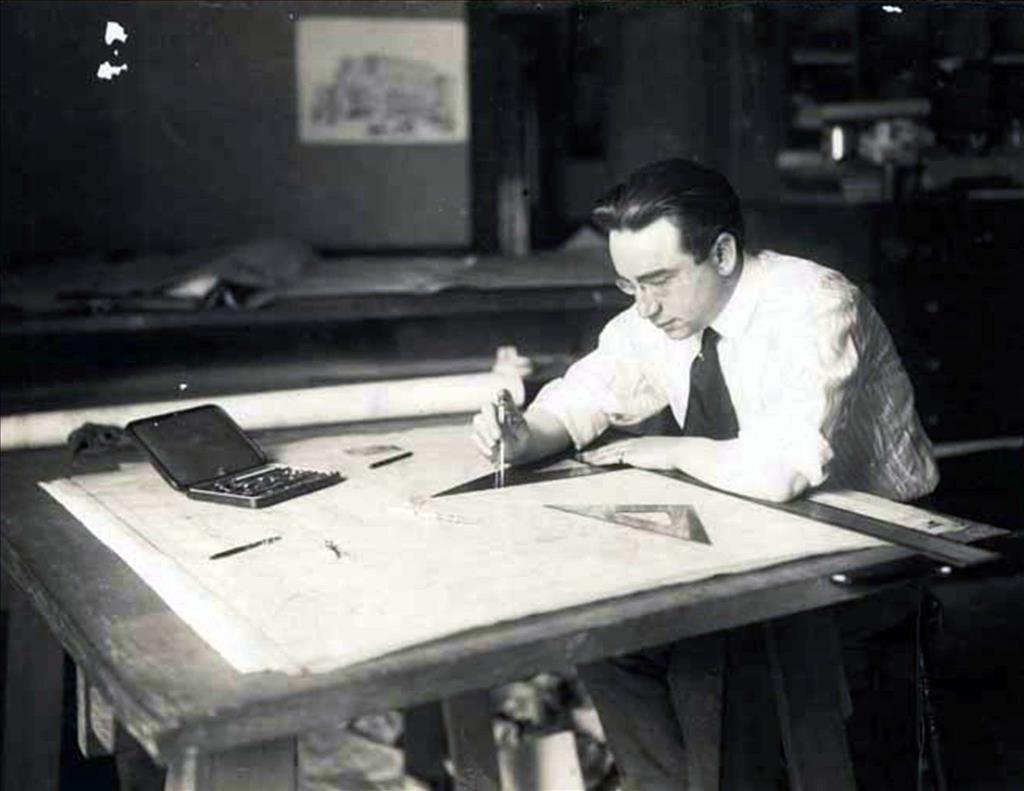B. Marcus Priteca’s 1918 Pantages Theatre in Salt Lake City offered patrons a unique architectural experience through its exquisite and abundant plaster mouldings and decor, marble flooring, Tiffany chandeliers and skylight, opulent furnishings, and even one of the first air-conditioned control interior climates in a Utah building. Scroll to read more!
The Architect
B. Marcus Priteca
December 23, 1889 – October 1, 1971
Glasgow-born architect Benjamin Marcus Priteca settled in Seattle in the early 20th century after studies and apprenticeship at University of Edinburgh and the Royal School of Arts in London. In Seattle during 1910, he met the impresario Alexander Pantages, and shortly thereafter convinced Pantages to design his new theatre in San Francisco in 1911. From that project, he went on to design many theaters for Pantages, including the Salt Lake City Pantages Theatre.
Some people have coined the architectural style of Priteca’s theatres as “Pantages Greek, an amalgamation of elements from revived antiquity. Due to the blending of styles, his theaters are not considered true “Greek Revival”. However, many of his theatres designs have been classified in general as built in the Second Renaissance Revival style.
The Salt Lake City Pantages Theatre contains many of the classic elements of Greek Revival, including pilasters, cornices, entablature, moldings, dentils, consols, and balustrades. However, the architecture’s historical eclecticism is revealed through the presence of the composite column orders (show) or Pompeian wall panels, which are considered to be Romanesque. The overabundance of decoration and frescoes could be considered Baroque, and in accordance with the time of its construction, the Tiffany chandeliers and original furnishings sprinkle the theater with traces of the Art Nouveau movement.
READ MORE
Read more about the life and work of B. Marcus Priteca on HistoryLink by clicking below.
See B. Marcus Priteca’s hand-drawn blueprints for the 1918 Salt Lake Pantages Theatre.
These blueprints are the only survivors from the drawing set. They were a part of the Utah State Historic Preservation Office’s collection of Shipler Commercial photographs.
Floor Plan Digital Restoration
Many of the historic glass-backed negatives scans of the blueprints had been damaged before they were able to be digitally scanned by the State Historic Preservation Office in 2008. Modern Out West, as part of the documentation of the theater’s history, digitally repaired the blueprint of the main floor to eliminate the shattering and restore the original blueprint for future preservationists and historians. Use the comparison slider below to view the difference between the original and restored blueprint.
Air Conditioning
The Pantages Theatre in Salt Lake City is home to one of the first air conditioning systems in the state of Utah.
“By means of the ventilating system, one of the largest and best of its kind, every cubic inch of air in the structure is changed every three and a half minutes. Air is taken from the roof, washed with cold water, heated to a correct temperature, then distributed through the building from 800 “mushroom” ventilators in the first floor and balcony. It is then forced up through the roof. The method, known as the Sturdevant system, was installed at a cost of $65,000. By means of automatic adjusters the temperature is kept at any desired degree, winter or summer. In the warm season, the air will be cooled with ice.” (Salt Lake Tribune, 17 November 1920).
READ MORE
Peruse the 1916 Sturtevant Catalogue by clicking below. The pamphlet courtesy of Penn State describes, illustrates, and diagrams primitive HVAC heating and cooling methods for the systems used in the Pantages.
Allegories & Amenities
The wall panel moldings, cast in plaster, are particularly unique details for the Pantages theatre. The panels depict different figures, represent different arts. The frescoes and other paintings throughout the theater also represent similar thematics. Also, the art glass lamp in the center of the theater is a recognizable Pantages vaudeville house trademark.
In the newspapers prefacing the theatre’s opening, they also quoted that the lighting system in the Pantages was to be “one of the best in the country”, boasting 16 miles of electrical conduit throughout. An unseen, yet well-heard expense was built at $35,000 under the stage. The orchestral organ under the stage was compared to be more powerful than a 52-piece orchestra.
Structural Truss
One of the main structural elements of the theater beside its concrete foundation and masonry walls was the “warren” style truss that helped provide the structural rigidity for such a large, expansive open space like the interior of the theater, as well as holding up the mezzanine level.
Englishmen James Warren and Willoughby Monzani patented this design in 1848. Their truss design uses equilateral diagonal beams to alternate between forces of compression and tension on the structure. As a warren truss’s length increases, so must its height, thus the scale of the truss above. It is easy to see from these Shipler Commercial photographs of the construction of the Pantages why some citizens and officials were upset about the use of materials for this project. Using such an important resource, such as steel, to make the truss for this “entertainment house” was extremely controversial during wartime, when metal was a very precious resource for the war effort.
Plenty of Plaster
All in all, over 400 tons of plaster were used for the mouldings and decorations inside the Pantages Theatre. The “decorative and ornamental features” of the Salt Lake City Pantages Theatre amounted to a whopping cost of $78,000 estimated equivalent to today’s $1,015,092. It is for reasons like the Sturdevant system and these opulent moldings that the Pantages Theatre in Salt Lake City was considered a destination by its patrons.






































































































